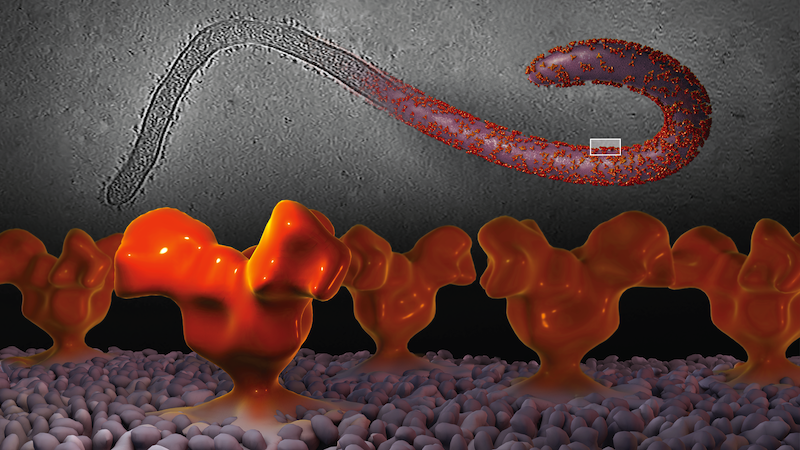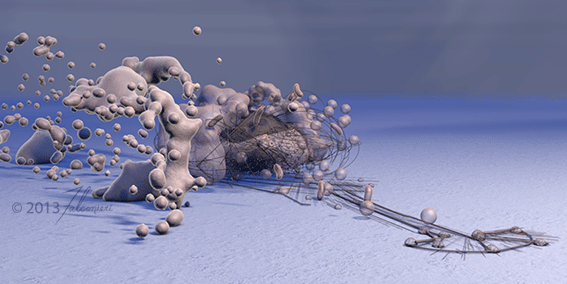
Biomedical Illustrator
Career Profile
Please introduce yourself. What is your current training/educational status and/or where do you work? How did you decide to get into scientific visualization?
I am a biomedical illustrator at the National Cancer Institute of the National Institutes of Health in Bethesda, MD. I work within the High Resolution Electron Microscopy Lab led by Sriram Subramaniam.
I earned my M.A. in Medical and Biological Illustration at the Johns Hopkins University School of Medicine (JHUSOM). I decided to get into scientific visualization back in high school, which is unusually early. I was lucky enough to hear of the field through family members who had met medical illustrators. Since I was torn between pursuing art or science in college, it was an epiphany to hear of a profession that mixed the two.
What do you like the most about this field?
Working with experts in their fields and learning new things all the time. My favorite moments are when I am working with a scientist on a visual and my visualization creates an “Ah ha” moment for them. They gain a deeper understanding or realize a nuance they had missed before.
How and where did you acquire your current skillset in scientific visualization? Was it all via a graduate or other program or are you self taught? If so, did you use any particular online resources to help with your training?
The foundation and majority of my skillset came from the curriculum of Masters program at the Department of Art as Applied to Medicine at JHUSOM.
However, I always am trying to figure out new techniques. The Association of Medical Illustrators conferences can be great places to get introduced to new techniques, and usually I’ll take notes of what I might be able to use and then Google for details later when I sit down to work on it.
One resource that I particularly like, just for general knowledge of Cinema4D rendering and animation techniques, is GreyScaleGorilla. Otherwise I am agnostic to the source of the tutorials I find in my Google searches.


What do you consider some of the biggest barriers to entering the field? Are they technical, training, scientific, professional (availability of jobs or projects)?
I think some of the biggest barriers to entering the field are actually quite early, before college even. Unfortunately the opportunity and resources to pursue science and art at a young age, and to do so without discouragement, are still privileges available to relatively few.
Which practitioners (or what visualizations) have been most inspirational to you?
“The Inner Life of the Cell” animation by XVIVO was a formative scientific visualization for me. It was the first time I had seen molecules approached in such a dramatic, artistic way. I watched it and thought “if everyone imagined molecules this way, no one would be flunking their biology classes”. It inspired me to learn more, as I think it does others. Though it’s easy to criticize its lack of absolute scientific accuracy, I think if it inspires someone to learn more (and then figure out what was wrong!), then it’s an effective visual.
I am also inspired by any artist who has reached a mastery of their technique. You see their work, be it in pen and ink, digital painting, or 3D animation, and its effortlessness, effectiveness, and sheer aesthetic appeal are inspiring. Their work reminds one of what waits beyond thousands of hours of work, and that every project isn’t just an end to itself, but a step in your journey as an artist.
Which conferences would you recommend to those interested in this field and why? What particular insights or benefits did you get out of attending this (these) conferences?
The Association of Medical Illustrators (AMI) conference is particularly good for those seeking to pursue scientific visualization professionally. Though the gallery and talks you can see the diversity of the field. Moreover, it’s a great conference for meeting people and learning about the many niches within the niche field of medical illustration.
The AMI conference also has great technique workshops, demos, and talks geared toward continuing education ranging from anatomy to molecular to business topics.
If there was one resource, tool or conference that you could wish for to facilitate your work, what would it be?
A local shared studio space with other scientific and medical visualization professionals. It would be awesome to have somewhere to go work with my peers in the same place, so we could talk shop, review each other’s work, and learn from each other. This was one of the highlights of graduate school, since we were all in close quarters working on similar projects.
What other advice would you offer those interested in either a professional or full-time academic career in scientific visualization?
Research people currently in the field, find ones who are doing what you would like to do, and reach out to them for informational interviews. Find out how they got there.
However, if they seem to have a different background than yours, remember that people can end up in similar positions but build their skillsets in different ways. There are medical illustrators and scientific visualizers that came from predominantly science backgrounds, and those that come from predominantly art backgrounds. It’s just a matter of filling in the appropriate skillsets once you decide that scientific visualization is what you want to do.

Please comment briefly on the samples/links that you have submitted for this profile… why in particular are you proud of these and what do you hope viewers will notice and get from seeing them?
I wanted to include a range of work, so readers will get an idea of just how diverse even one person’s portfolio can be. Ebola in 3D is a great example of making scientific data accessible to the public. The Gracilis Muscle Graft is an example of more traditional illustration applied to a surgical subject matter. Finally, Dissolving the Cell Membrane is an example of both an animation and a visualization of a scientific method.
Where do you think the field of scientific visualization is ‘going’? Do you perceive any trends in its evolution or are there certain directions that you would like to see implemented?
I think the scientific community is becoming more aware of the need to communicate in methods beyond publications and traditional presentations, as well as the ability of visualization to benefit data analysis and inform experimental strategy. As these needs and benefits become more apparent, there will be more visual experts integrated more closely with scientific institutions.
And then let’s end with a simple question… What is your ‘10 year plan’ in terms of what you hope to accomplish in scientific visualization?
I want to continue solving visual challenges for science, creating “Ah ha” moments for expert audiences, and “Wow!” moments for all audiences. Of course, I also want to continue learning new techniques and sharpening my skills. One way that I can see integrating both of those things is eventually taking on a teaching role — helping students find their “ah ha” moments, and being constantly challenged to keep at the forefront of an evolving field.
